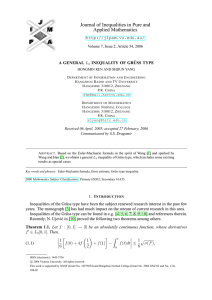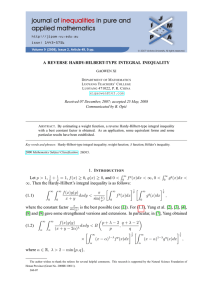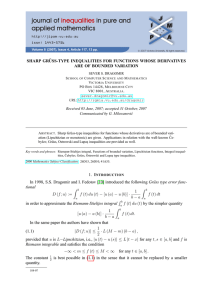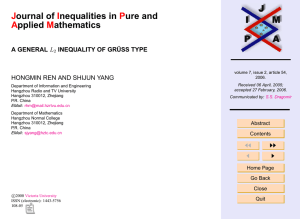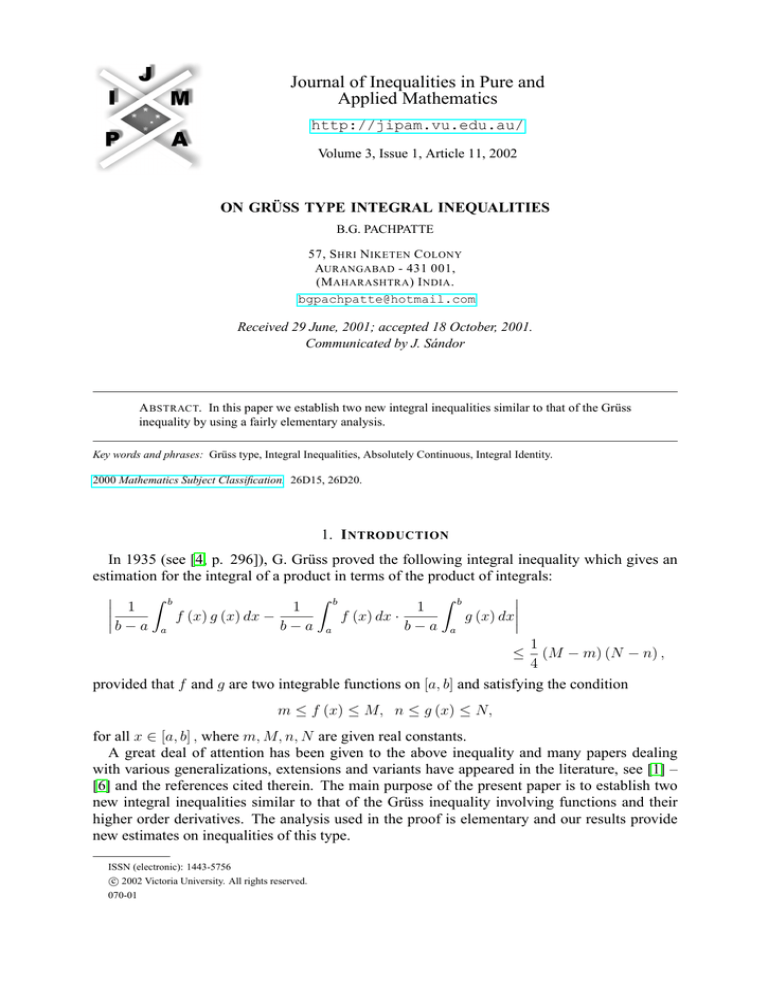
Journal of Inequalities in Pure and
Applied Mathematics
http://jipam.vu.edu.au/
Volume 3, Issue 1, Article 11, 2002
ON GRÜSS TYPE INTEGRAL INEQUALITIES
B.G. PACHPATTE
57, S HRI N IKETEN C OLONY
AURANGABAD - 431 001,
(M AHARASHTRA ) I NDIA .
bgpachpatte@hotmail.com
Received 29 June, 2001; accepted 18 October, 2001.
Communicated by J. Sándor
A BSTRACT. In this paper we establish two new integral inequalities similar to that of the Grüss
inequality by using a fairly elementary analysis.
Key words and phrases: Grüss type, Integral Inequalities, Absolutely Continuous, Integral Identity.
2000 Mathematics Subject Classification. 26D15, 26D20.
1. I NTRODUCTION
In 1935 (see [4, p. 296]), G. Grüss proved the following integral inequality which gives an
estimation for the integral of a product in terms of the product of integrals:
Z b
Z b
Z b
1
1
1
f
(x)
g
(x)
dx
−
f
(x)
dx
·
g
(x)
dx
b − a
b
−
a
b
−
a
a
a
a
1
≤ (M − m) (N − n) ,
4
provided that f and g are two integrable functions on [a, b] and satisfying the condition
m ≤ f (x) ≤ M, n ≤ g (x) ≤ N,
for all x ∈ [a, b] , where m, M, n, N are given real constants.
A great deal of attention has been given to the above inequality and many papers dealing
with various generalizations, extensions and variants have appeared in the literature, see [1] –
[6] and the references cited therein. The main purpose of the present paper is to establish two
new integral inequalities similar to that of the Grüss inequality involving functions and their
higher order derivatives. The analysis used in the proof is elementary and our results provide
new estimates on inequalities of this type.
ISSN (electronic): 1443-5756
c 2002 Victoria University. All rights reserved.
070-01
2
B.G. PACHPATTE
2. S TATEMENT OF R ESULTS
In this section, we state our results to be proved in this paper. In what follows, we denote by
R, the set of real numbers and [a, b] ⊂ R, a < b.
Our main results are given in the following theorems.
Theorem 2.1. Let f, g : [a, b] → R be functions such that f (n−1) , g (n−1) are absolutely continuous on [a, b] and f (n) , g (n) ∈ L∞ [a, b] . Then
Z b
Z b
Z b
1
1
1
(2.1) f (x) g (x) dx −
f (x) dx
g (x) dx
b−a a
b−a a
b−a a
!
!
# Z b" X
n−1
n−1
X
1
−
F
(x)
g
(x)
+
G
(x)
f
(x)
dx
k
k
2
2 (b − a) a
k=1
k=1
Z b
(n) 1
f + |f (x)| g (n) An (x) dx,
≤
|g
(x)|
∞
∞
2 (b − a)2 a
where
"
(2.2)
(2.3)
(2.4)
#
(b − x)k+1 + (−1)k (x − a)k+1 (k)
Fk (x) =
f (x) ,
(k + 1)!
"
#
(b − x)k+1 + (−1)k (x − a)k+1 (k)
Gk (x) =
g (x) ,
(k + 1)!
Z b
An (x) =
|Kn (x, t)| dt,
a
2
in which Kn : [a, b] → R is given by
(2.5)
(t − a)n
if t ∈ [a, x]
n!
Kn (x, t) =
n
(t − b)
if t ∈ (x, b]
n!
and
(n) f =
∞
(n) g =
∞
sup f (n) (t) < ∞,
t∈[a,b]
sup g (n) (t) < ∞,
t∈[a,b]
for x ∈ [a, b] and n ≥ 1 a natural number.
Theorem 2.2. Let p, q : [a, b] → R be functions such that p(n−1) , q (n−1) are absolutely continuous on [a, b] and p(n) , q (n) ∈ L∞ [a, b] . Then
Z b
Z b
Z b
1
1
1
(2.6) p (x) q (x) dx − n
p (x) dx
q (x) dx
b−a a
b−a a
b−a a
!
!
# Z b" X
n−1
n−1
X
1
+
Pk (x) q (x) +
Qk (x) p (x) dx
2 (b − a) a
k=1
k=1
Z b
(n) 1
p + |p (x)| q (n) Bn (x) dx,
≤
|q
(x)|
∞
∞
2 (n − 1)! (b − a)2 a
J. Inequal. Pure and Appl. Math., 3(1) Art. 11, 2002
http://jipam.vu.edu.au/
G RÜSS T YPE I NTEGRAL I NEQUALITIES
3
where
(n − k) p(k−1) (a) (x − a)k − p(k−1) (b) (x − b)k
·
,
k!
b−a
(n − k) q (k−1) (a) (x − a)k − q (k−1) (b) (x − b)k
Qk (x) =
·
,
k!
b−a
Z b
(x − t)n−1 r (t, x) dt,
Bn (x) =
Pk (x) =
(2.7)
(2.8)
(2.9)
a
in which
r (t, x) =
t − a, if a ≤ t ≤ x ≤ b,
t − b, if a ≤ x < t ≤ b,
and
(n) p =
∞
(n) q =
∞
sup p(n) (t) < ∞,
t∈[a,b]
sup q (n) (t) < ∞,
t∈[a,b]
for x ∈ [a, b] and n ≥ 1 is a natural number.
3. P ROOF OF T HEOREM 2.1
From the hypotheses on f, we have the following integral identity (see [1, p. 52]):
Z
(3.1)
a
b
"
#
n−1
X
(b − x)k+1 + (−1)k (x − a)k+1 (k)
f (t) dt =
f (x)
(k
+
1)!
k=0
n
Z
+ (−1)
b
Kn (x, t) f (n) (t) dt,
a
for x ∈ [a, b] . In [1] the identity (3.1) is proved by mathematical induction. For a different
proof, see [6]. The identity (3.1) can be rewritten as
(3.2)
1
f (x) =
b−a
Z
b
a
n−1
1 X
(−1)n
f (t) dt −
Fk (x) −
b − a k=1
b−a
b
Z
Kn (x, t) f (n) (t) dt.
a
Similarly, from the hypotheses on g we have the identity
(3.3)
1
g (x) =
b−a
Z
a
b
n−1
1 X
(−1)n
g (t) dt −
Gk (x) −
b − a k=1
b−a
J. Inequal. Pure and Appl. Math., 3(1) Art. 11, 2002
Z
b
Kn (x, t) g (n) (t) dt.
a
http://jipam.vu.edu.au/
4
B.G. PACHPATTE
Multiplying (3.2) by g (x) and (3.3) by f (x) and summing the resulting identities and integrating from a to b and rewriting we have
1
(3.4)
b−a
Z b
Z b
1
1
f (x) g (x) dx =
f (x) dx
g (x) dx
b−a a
b−a a
a
!
!
#
Z b" X
n−1
n−1
X
1
−
Fk (x) g (x) +
Gk (x) f (x) dx
2 (b − a)2 a
k=1
k=1
Z b
Z
1
(−1)n b
(n)
−
g (x)
Kn (x, t) f (t) dt dx
b−a a
2 (b − a)2 a
Z
Z b
(−1)n b
(n)
Kn (x, t) g (t) dt dx .
+
f (x)
b−a a
a
Z
b
From (3.4) we observe that
Z b
Z b
Z b
1
1
1
f (x) g (x) dx −
f (x) dx
g (x) dx
b − a
b−a a
b−a a
a
!
!
# Z b" X
n−1
n−1
X
1
−
Fk (x) g (x) +
Gk (x) f (x) dx
2
2 (b − a) a
k=1
k=1
1
≤
2 (b − a)2
Z b
Z
|g (x)|
a
b
(n) |Kn (x, t)| f (t) dt
a
Z
+ |f (x)|
b
(n) |Kn (x, t)| g (t) dt
dx
a
≤
1
2 (b − a)2
Z
b
a
|g (x)| f (n) ∞ + |f (x)| g (n) ∞ An (x) ,
which is the required inequality in (2.1). The proof is complete.
4. P ROOF OF T HEOREM 2.2
From the hypotheses on p we have the following integral identity (see [2, p. 291]):
!
Z b
n−1
X
1
1
(4.1)
p (x) +
Pk (x) −
p (y) dy
n
b
−
a
a
k=1
Z b
1
=
(x − t)n−1 r (t, x) p(n) (t) dt,
n! (b − a) a
for x ∈ [a, b] . The identity (4.1) can be rewritten as
n
(4.2) p (x) =
b−a
Z
b
p (x) dx −
a
n−1
X
Pk (x)
k=1
1
+
(n − 1)! (b − a)
J. Inequal. Pure and Appl. Math., 3(1) Art. 11, 2002
Z
b
(x − t)n−1 r (t, x) p(n) (t) dt.
a
http://jipam.vu.edu.au/
G RÜSS T YPE I NTEGRAL I NEQUALITIES
5
Similarly, from the hypotheses on q we have the identity
Z b
n−1
X
n
Qk (x)
(4.3) q (x) =
q (x) dx −
b−a a
k=1
Z b
1
+
(x − t)n−1 r (t, x) q (n) (t) dt.
(n − 1)! (b − a) a
Multiplying (4.2) by q (x) and (4.3) by p (x) and summing the resulting identities and integrating from a to b and rewriting we have
Z b
Z b
Z b
1
1
1
p (x) q (x) dx = n
p (x) dx
q (x) dx
(4.4)
b−a a
b−a a
b−a a
!
!
#
Z b" X
n−1
n−1
X
1
−
Pk (x) q (x) +
Qk (x) p (x) dx
2 (b − a) a
k=1
k=1
Z b
Z b
1
n−1
(n)
+
q (x)
(x − t)
r (t, x) p (t) dt dx
2 (n − 1)! (b − a)2 a
a
Z b
Z b
n−1
(n)
+
p (x)
(x − t)
r (t, x) q (t) dt dx .
a
a
From (4.4) and following the similar arguments as in the last part of the proof of Theorem 2.1,
we get the desired inequality in (2.6). The proof is complete.
R EFERENCES
[1] P. CERONE, S.S. DRAGOMIR AND J. ROUMELIOTIS, Some Ostrowski type inequalities for n−time differentiable mappings and applications, Demonstratio Mathematica,
32(2) (1999), 679–712. RGMIA Research Report Collection, 1(1) (1998), 51–66. ONLINE:http://rgmia.vu.edu.au/v1n1.html
[2] A.M. FINK, Bounds on the deviation of a function from its averages, Chechslovak Math. Jour., 42
(1992), 289–310.
[3] G.V. MILOVANOVIĆ AND J.E. PEČARIĆ, On generalization of the inequality of A. Ostrowski and
some related applications, Univ. Beograd. Publ. Elek. Fak. Ser. Mat. Fiz., 544–576 (1976), 155–158.
[4] D.S MITRINOVIĆ, J.E. PEČARIĆ AND A.M. FINK, Classical and New Inequalities in Analysis,
Kluwer Academic Publishers, Dordrecht, 1993.
[5] B.G. PACHPATTE, A note on some inequalities analogous to Grüss inequality, Octogon Math. Magazine, 5 (1997), 62–66.
[6] J. SÁNDOR, On the Jensen-Hadamard inequality, Studia Univ. Babes-Bolyai, Math., 36(1) (1991),
9–15.
J. Inequal. Pure and Appl. Math., 3(1) Art. 11, 2002
http://jipam.vu.edu.au/







